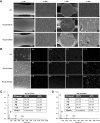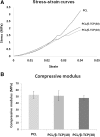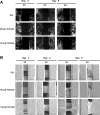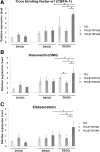PCL/β-TCP Composite Scaffolds Exhibit Positive Osteogenic Differentiation with Mechanical Stimulation
- PMID: 30603491
- PMCID: PMC6171607
- DOI: 10.1007/s13770-017-0022-9
PCL/β-TCP Composite Scaffolds Exhibit Positive Osteogenic Differentiation with Mechanical Stimulation
Abstract
We investigated the use of Polycaprolactone (PCL)/ β-tricalcium phosphate (β-TCP) composites with applied mechanical stimulation as scaffold for bone tissue engineering. PCL-based three-dimensional (3D) structures were fabricated in a solvent-free process using a 3D-printing technique. The mass fraction of β-TCP was varied in the range 0-30%, and the structure and compressive modulus of the specimens was characterized. The shape and interconnectivity of the pores was found to be satisfactory, and the compressive modulus of the specimens was comparable with that of human trabecular bone. Human mesenchymal stem cells were seeded on the composites, and various biological evaluations were performed over 9 days. With a mass fraction of β-TCP of 30%, differentiation began earlier; however, the cell proliferation rate was lower. Through the use of mechanical stimulation, however, the proliferation rate recovered, and was comparable with that of the other groups. This stimulation effect was also observed in ECM generation and other biological assays. With mechanical stimulation, expression of osteogenic markers was lower on samples with a β-TCP content of 10 wt% than without β-TCP; however, with mechanical stimulation, the sample with a β-TCP content of 30 wt% exhibited significantly greater expression of those markers than the other samples. We found that mechanical stimulation and the addition of β-TCP interacted closely, and that a mass fraction of β-TCP of 30% was particularly useful as a bone tissue scaffold when accompanied by mechanical stimulation.
Keywords: 3D-printing system; Human mesenchymal stem cell; Polycaprolactone (PCL); Scaffold; β-tricalcium phosphate (β-TCP).
Conflict of interest statement
The authors have no financial conflict of interest.There are no animal experiments carried out for this article.
Figures








Similar articles
-
3D printed polycaprolactone/β-tricalcium phosphate/carbon nanotube composite - Physical properties and biocompatibility.Heliyon. 2024 Feb 20;10(5):e26071. doi: 10.1016/j.heliyon.2024.e26071. eCollection 2024 Mar 15. Heliyon. 2024. PMID: 38468962 Free PMC article.
-
Composite PCL Scaffold With 70% β-TCP as Suitable Structure for Bone Replacement.Int Dent J. 2024 Dec;74(6):1220-1232. doi: 10.1016/j.identj.2024.02.013. Epub 2024 Apr 13. Int Dent J. 2024. PMID: 38614878 Free PMC article.
-
Fabrication of Solvent-Free PCL/β-TCP Composite Fiber for 3D Printing: Physiochemical and Biological Investigation.Polymers (Basel). 2023 Mar 10;15(6):1391. doi: 10.3390/polym15061391. Polymers (Basel). 2023. PMID: 36987176 Free PMC article.
-
Osteogenesis of adipose-derived stem cells on polycaprolactone-β-tricalcium phosphate scaffold fabricated via selective laser sintering and surface coating with collagen type I.J Tissue Eng Regen Med. 2016 Oct;10(10):E337-E353. doi: 10.1002/term.1811. Epub 2013 Aug 16. J Tissue Eng Regen Med. 2016. PMID: 23955935
-
3D-printed MgO nanoparticle loaded polycaprolactone β-tricalcium phosphate composite scaffold for bone tissue engineering applications: In-vitro and in-vivo evaluation.J Biomed Mater Res A. 2023 Mar;111(3):322-339. doi: 10.1002/jbm.a.37465. Epub 2022 Nov 5. J Biomed Mater Res A. 2023. PMID: 36334300
Cited by
-
Design and Analysis of a Biodegradable Polycaprolactone Flow Diverting Stent for Brain Aneurysms.Bioengineering (Basel). 2021 Nov 12;8(11):183. doi: 10.3390/bioengineering8110183. Bioengineering (Basel). 2021. PMID: 34821749 Free PMC article.
-
Polycaprolactone for Hard Tissue Regeneration: Scaffold Design and In Vivo Implications.Bioengineering (Basel). 2025 Jan 8;12(1):46. doi: 10.3390/bioengineering12010046. Bioengineering (Basel). 2025. PMID: 39851320 Free PMC article. Review.
-
Fully Defined 3D Hybrid System for Bone Tissue Engineering: Integration of MeHA-RGD/PCL-TCP Scaffolds With Human Stem Cells via 3D-Printed Vacuum-Assisted Cell Loading Device.J Tissue Eng Regen Med. 2025 Jul 3;2025:7287217. doi: 10.1155/term/7287217. eCollection 2025. J Tissue Eng Regen Med. 2025. PMID: 40642420 Free PMC article.
-
Surgical Site-Released Tissue Is Potent to Generate Bone onto TCP and PCL-TCP Scaffolds In Vitro.Int J Mol Sci. 2023 Nov 1;24(21):15877. doi: 10.3390/ijms242115877. Int J Mol Sci. 2023. PMID: 37958857 Free PMC article.
-
Near-Infrared Contrast Agents for Bone-Targeted Imaging.Tissue Eng Regen Med. 2019 Aug 19;16(5):443-450. doi: 10.1007/s13770-019-00208-9. eCollection 2019 Oct. Tissue Eng Regen Med. 2019. PMID: 31624700 Free PMC article. Review.
References
-
- O’Brien FJ. Biomaterials and scaffolds for tissue engineering. Materialstoday. 2011;14:88–95.
-
- Park SA, Lee JB, Kim YE, Kim JE, Lee JH, Shin J, et al. Fabrication of biomimetic PCL scaffold using rapid prototyping for bone tissue engineering. Macromol Res. 2014;22:882–887. doi: 10.1007/s13233-014-2119-5. - DOI
-
- Su J, Chen L, Li L. Characterization of polycaprolactone and starch blends for potential application within the biomaterials field. Afr J Biotechnol. 2012;11:694–701.
LinkOut - more resources
Full Text Sources
